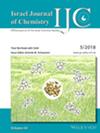Fabricating Quasiperiodic Tilings with Thermal-Scanning Probe Lithography
IF 2.3
4区 化学
Q3 CHEMISTRY, MULTIDISCIPLINARY
引用次数: 0
Abstract
We outline an approach to fabricate nanoscale artificial quasiperiodic tilings with thermal-scanning probe lithography. Quasiperiodic tilings such as the Ammann-Beenker, Square Fibonacci tiling, and Penrose are fabricated and imaged with thermal-conductance feedback microscopy, followed by electron microscopy. The design implementation, chemical, and physical challenges involved in fabricating such artificial systems using nanolithography are discussed. Additionally, the potential applications of fabricated quasiperiodic tilings are explored.


用热扫描探针光刻技术制作准周期性顶棚
1 引言 准晶体表现出长程非周期性秩序,这使其有别于周期性晶体材料。1, 2 表征原子尺度准晶体的物理性质面临若干挑战,主要原因是原子的非周期性排列使结构确定变得复杂,需要先进的测量技术。尤其是,现有的准晶体种类仅限于某些结构,例如二十面体、十边形和十二边形系统。准晶体的生长方法有 Czochralski 法、布里奇曼法、浮区法或自流法。利用各种衍射、光谱和显微镜技术对准晶体的块体和表面特性进行表征。6 还在准晶体表面生长了原子叠层的假象系统。在纳米到介观尺度上,纳米光刻制造技术为精确设计纳米结构的尺寸、形状和排列提供了新的可能性,从而实现了量身定制的功能。18 总体而言,文献中描述的三种主要纳米光刻技术都可用于制作准周期倾斜面(见表 1):扫描探针光刻技术 (SPL)、电子束光刻技术 (EBL) 和光刻技术。在 SPL 中,直接写入探针通过化学或物理方式重新排列、蚀刻或移除原子或分子来操纵基底表面。热扫描探针光刻(t-SPL)等技术通过加热探针使其热升华来去除表面原子或分子19。EBL 包括通过覆盖基底特定区域的掩膜用聚焦电子束照射表面,或使用电子束光刻胶直接写入与 SPL 类似的图案。抗蚀剂是一种材料,通常是聚合物,其设计目的是在特定刺激下分解,从而将图案从掩膜或直接转移到基底上。EBL 分辨率受限于与光刻胶相互作用的电子的去布罗格利波长,但与 SPL 等直接写入工艺不同的是,需要对充电和邻近效应进行校正。最后,在光刻技术中,光敏光刻胶通过掩膜或直接聚焦光束,利用入射光子进行图案化。在这种技术中,准周期莫伊纹图案由多束干涉光束产生,其周期、空间频率或角度不可调制20。由于这些技术中使用的光子波长较长,因此分辨率比 SPL 或 EBL 低。表 1 总结了近期纳米光刻法制造准周期性薄片的情况,列出了所使用的技术,并简要介绍了所探索的薄片和主要结果。用各种纳米光刻技术制作的准周期菱形。技术描述作者st-SPL12-fold reciprocal space etched gratingfor photolithography.Lassaline, et al.21 EBL10-fold Penrose22 和 Fibonacci23superconducting pinning arrays.Kemmler, et al.22 和 Villegas, et al.23 Shi 等人 24 10 倍彭罗斯和 8 倍安曼-贝克尔层叠的磁特性》,Bhat、Farmer、Sung 等人 25-30Varadarajan 和 Shekar,13 Mahmood 等人,20 Yang 和 Wangl,31 Vitias 等人。杨和王尔、31 Vitiello 等人、32 奚和孙、33 Langner 等人、34 以及高和刘35 本文旨在从教学角度展示制作准周期系统的相关挑战,以及如何利用 t-SPL 技术克服这些挑战。本文介绍了成功制作的倾斜系统的结果,以及一系列可能的用途。
本文章由计算机程序翻译,如有差异,请以英文原文为准。
求助全文
约1分钟内获得全文
求助全文
来源期刊

Israel Journal of Chemistry
化学-化学综合
CiteScore
6.20
自引率
0.00%
发文量
62
审稿时长
6-12 weeks
期刊介绍:
The fledgling State of Israel began to publish its scientific activity in 1951 under the general heading of Bulletin of the Research Council of Israel, which quickly split into sections to accommodate various fields in the growing academic community. In 1963, the Bulletin ceased publication and independent journals were born, with Section A becoming the new Israel Journal of Chemistry.
The Israel Journal of Chemistry is the official journal of the Israel Chemical Society. Effective from Volume 50 (2010) it is published by Wiley-VCH.
The Israel Journal of Chemistry is an international and peer-reviewed publication forum for Special Issues on timely research topics in all fields of chemistry: from biochemistry through organic and inorganic chemistry to polymer, physical and theoretical chemistry, including all interdisciplinary topics. Each topical issue is edited by one or several Guest Editors and primarily contains invited Review articles. Communications and Full Papers may be published occasionally, if they fit with the quality standards of the journal. The publication language is English and the journal is published twelve times a year.
 求助内容:
求助内容: 应助结果提醒方式:
应助结果提醒方式:


